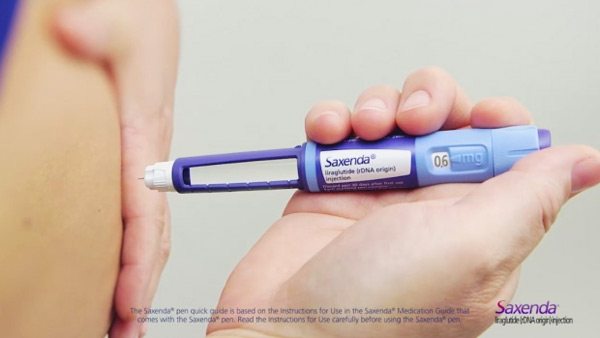People who injected Saxenda (liraglutide) every day for a year lost an average of 18.5 pounds, compared with an average of 6 pounds for those taking a placebo, researchers found.

What is this Saxenda?
It’s a higher dose of Victoza, which has been available in the US since 2010 for the treatment of type 2 diabetes. Liraglutide is a glucagon-like peptide-1 (GLP-1) receptor agonist. The dose for obesity is 3.0 mg (Saxenda), in contrast to 1.2 mg or 1.8 mg for diabetes (Victoza).
Saxenda now becomes the fifth available obesity drug in the United States, joining orlistat (Xenical or Alli), Belviq, Qsymia, and Contrave. It is very different from all other weight loss drugs. For one thing, it is a once-a-day injection, like some diabetes medications, instead of a pill. For another, it works in an entirely different way, mimicking a naturally-occurring hormone that your intestine secretes when you eat food.
The drug is injected and works by mimicking the glucagon-like peptide, or GLP-1, a hormone that communicates satiety to the brain so that we eat less.
Benefits

Saxenda “can lower weight, improve cardiovascular risk factors and improve quality of life,” said lead researcher Dr. F. Xavier Pi-Sunyer, professor of medicine at Columbia University Medical Center in New York City.
“It can also reduce the progression to type 2 diabetes from prediabetes,” he said. In a lower-dose version called Victoza, liraglutide is approved for diabetes treatment. One of the most important attributes is that it can be used effectively long term, for chronic management of obesity. It is not like the appetite suppressant weight loss drugs that only work for a while. Like other medications used for diabetes, it introduces a hormone that compensates for a deficiency.
Like The Anderson Method, which is a behavioral weight loss program for people with chronic obesity, Saxenda is not for lightweights, people without a serious weight control problem or who only need to lose a few pounds. Saxenda is appropriate for people who are clinically obese with a Body Mass Index (BMI) of 30 or a BMI of 27 with another medical condition, like high blood pressure or diabetes. For example, someone who is 5’4″ would have to be at least 157 pounds with a medical condition, or 174 pounds without an additional medical condition.
In the research study, participants (3,700 overweight or obese people without diabetes) were assigned to daily injections of Saxenda or placebo for 56 weeks. Both groups also received lifestyle counseling. More than half had prediabetes. Sixty-three percent of patients taking Saxenda lost at least 5 percent of their initial body weight, and one-third lost more than 10 percent of body weight. Among those receiving placebo, 27 percent lost 5 percent of their body weight, and one in 10 lost more than 10 percent of their body weight.
Side Effects
The most common side effects with Saxenda were mild or moderate nausea and diarrhea. The serious ones are thyroid tumors and pancreatitis. If you have one of several conditions, like a history of thyroid cancer, this is not for you. Serious side effects occurred in 6.2 percent of patients taking Saxenda and in 5 percent of those receiving the placebo, the researchers report.
However, it’s important to remember that obesity is a lifestyle condition. There is an urgent need to adjust lifestyle — diet and exercise – then only medications can be helpful.
For more information:
The U.S. National Heart, Lung and Blood Institute has more on the health risks of obesity.
Disclaimer
The Content is not intended to be a substitute for professional medical advice, diagnosis, or treatment. Always seek the advice of your physician or other qualified health provider with any questions you may have regarding a medical condition.


